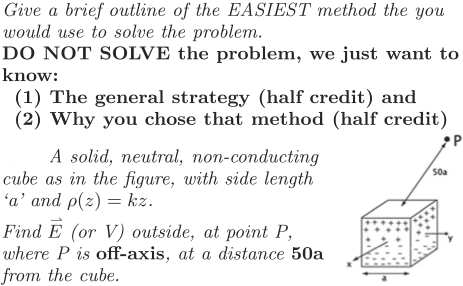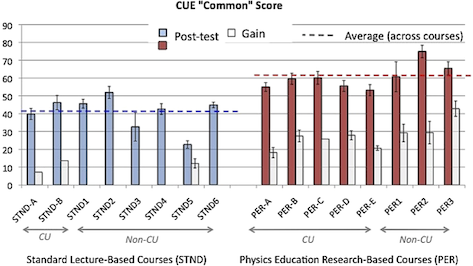Developed by Stephanie V. Chasteen, Rachel E. Pepper, Marcos D. Caballero, Steven J. Pollock, and Katherine K. Perkins
| Purpose | To assess skills in first semester upper-level E&M, such as the ability to visualize a problem, correctly apply problem-solving methods, connect math to physics, and describe limiting behavior. |
|---|---|
| Format | Pre/post, Short answer |
| Duration | Pre: 20 min; Post: 50 min |
| Focus | Electricity / Magnetism Content knowledge (electrostatics, magnetostatics, choosing a problem-solving method) |
| Level | Upper-level |
Sample question from the CUE-FR:
CUE-FR Implementation and Troubleshooting Guide
Everything you need to know about implementing the CUE-FR in your class.
Login or register to download the implementation guide.
The CUE-FR has been replaced with a multiple-choice version, the CUE-CMR.
The Colorado Science Education Initiative (SEI) has developed a wide range of curricular materials for teaching junior-level electrostatics, of which the CUE-FR is only one. Please visit the course website for other materials such as group activities, clicker questions, and homework.
more details
This is the highest level of research validation, corresponding to all seven of the validation categories below.
Research Validation Summary
Based on Research Into:
- Student thinking
Studied Using:
- Student interviews
- Expert review
- Appropriate statistical analysis
Research Conducted:
- At multiple institutions
- By multiple research groups
- Peer-reviewed publication
The free-response questions on the CUE-FR were developed based on previously established learning goals, expert input, and common difficulties observed during student interviews and homework help sessions. Questions were refined through expert review, additional student interviews and analysis of student performance on the test. Appropriate statistical analyses of difficulty, discrimination and internal consistency were conducted, and values found to be above the desired thresholds. When using the rubric, graders were able to usually (74% of the time) agree on a test's score within 5% and were always able to agree within 10%. CUE-FR scores correlate strongly with other measures of student learning and have been used to compare different teaching methods. The CUE-FR has been given to over 500 students at eight institutions. The results are published in three peer-reviewed publications.
References
- S. Chasteen, R. Pepper, M. Caballero, S. Pollock, and K. Perkins, Colorado Upper-Division Electrostatics diagnostic: A conceptual assessment for the junior level, Phys. Rev. ST Phys. Educ. Res. 8 (2), 020108 (2012).
- S. Chasteen and S. Pollock, Transforming Upper-Division Electricity and Magnetism, presented at the Physics Education Research Conference 2008, Edmonton, Canada, 2008.
- S. Chasteen, S. Pollock, R. Pepper, and K. Perkins, Transforming the junior level: Outcomes from instruction and research in E&M, Phys. Rev. ST Phys. Educ. Res. 8 (2), 020107 (2012).
- J. Zwolak, M. Kustusch, and C. Manogue, Re-thinking the Rubric for Grading the CUE: The Superposition Principle, presented at the Physics Education Research Conference 2013, Portland, OR, 2013.
- J. Zwolak and C. Manogue, Revealing Differences Between Curricula Using the Colorado Upper-Division Electrostatics Diagnostic, presented at the Physics Education Research Conference 2014, Minneapolis, MN, 2014.
- J. Zwolak and C. Manogue, Assessing student reasoning in upper-division electricity and magnetism at Oregon State University, Phys. Rev. ST Phys. Educ. Res. 11 (2), 020125 (2015).
We don't have any translations of this assessment yet.
If you know of a translation that we don't have yet, or if you would like to translate this assessment, please contact us!

Login or register to download an excel scoring and analysis tool for this assessment.
| Typical Results |
|---|
Typical results on CUE-FR from Chasteen et. al 2012 ‘‘Common’’ CUE scores across institutions for N=488 students. ‘‘Post-test’’ represents course average score (% correct) for the subset of CUE questions given in common across all exams (88 out of 118 possible points). ‘‘Gain’’ represents the course average (out of 100%) for the difference between the pretest (60 points) and the matched subset of the post-test (i.e., 60 points). PER courses used the research-based materials developed at CU. STND courses used a standard lecture-based format. Because of the lack of pretests for CU-RES1 and CU STND1 and STND2, pretest scores are estimated (and thus gain scores are effective and lack error bars) based on the stable pretest scores for other semesters. Courses are not listed chronologically. Courses A and B (from final CUE administration) are labeled. Error bars represent 1 standard error of the mean.
|
The latest version of the CUE-FR, released in 2012, is version 22. The CUE-CMR is the coupled multiple response version of the same assessment, which can be administered on scantrons and machine-graded. Version 9 is the latest version of the CUE-CMR, released in 2014, and is comparable to version 22 of the CUE-FR.
Variation
|
|
Colorado Upper Division Electrostatics Diagnostic - Coupled Multiple ResponseContent knowledge Electricity / Magnetism (electrostatics, magnetostatics, choosing a problem-solving method)Upper-level Pre/post, Multiple-choice, Multiple-response |




